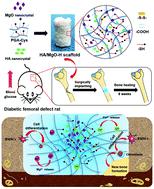当前位置:
X-MOL 学术
›
J. Mater. Chem. B
›
论文详情
Our official English website, www.x-mol.net, welcomes your
feedback! (Note: you will need to create a separate account there.)
HA/MgO nanocrystal-based hybrid hydrogel with high mechanical strength and osteoinductive potential for bone reconstruction in diabetic rats
Journal of Materials Chemistry B ( IF 6.1 ) Pub Date : 2020-12-14 , DOI: 10.1039/d0tb02553d Rui Chen 1, 2, 3, 4, 5 , Hang-Bo Chen 4, 5, 6, 7, 8 , Peng-Peng Xue 4, 5, 6, 7, 8 , Wai-Geng Yang 4, 5, 6, 7, 8 , Lan-Zi Luo 4, 5, 6, 7, 8 , Meng-Qi Tong 4, 5, 6, 7, 8 , Bin Zhong 4, 9, 10, 11 , He-Lin Xu 4, 5, 6, 7, 8 , Ying-Zheng Zhao 4, 5, 6, 7, 8 , Jian-Dong Yuan 1, 2, 3, 4
Journal of Materials Chemistry B ( IF 6.1 ) Pub Date : 2020-12-14 , DOI: 10.1039/d0tb02553d Rui Chen 1, 2, 3, 4, 5 , Hang-Bo Chen 4, 5, 6, 7, 8 , Peng-Peng Xue 4, 5, 6, 7, 8 , Wai-Geng Yang 4, 5, 6, 7, 8 , Lan-Zi Luo 4, 5, 6, 7, 8 , Meng-Qi Tong 4, 5, 6, 7, 8 , Bin Zhong 4, 9, 10, 11 , He-Lin Xu 4, 5, 6, 7, 8 , Ying-Zheng Zhao 4, 5, 6, 7, 8 , Jian-Dong Yuan 1, 2, 3, 4
Affiliation

|
Bone repair and regeneration processes are markedly impaired in diabetes mellitus (DM). Intervening approaches similar to those developed for normal healing conditions have been adopted to combat DM-associated bone regeneration. However, limited outcomes were achieved for these approaches. Hence, together with osteoconductive hydroxyapatite (HA) nanocrystals, osteoinductive magnesium oxide (MgO) nanocrystals were uniformly mounted into the network matrix of an organic hydrogel composed of cysteine-modified γ-polyglutamic acid (PGA-Cys) to construct a hybrid and rough hydrogel scaffold. It was hypothesized that the HA/MgO nanocrystal hybrid hydrogel (HA/MgO-H) scaffold can significantly promote bone repair in DM rats via the controlled release of Mg2+. The HA/MgO-H scaffold exhibited a sponge-like morphology with porous 3D networks inside it and displayed higher mechanical strength than a PGA-Cys scaffold. Meanwhile, the HA/MgO-H scaffold gradually formed a tough hydrogel with G′ of more than 1000 Pa after hydration, and its high hydration swelling ratio was still retained. Moreover, after the chemical degradation of the dispersed MgO nanocrystals, slow release of Mg2+ from the hydrogel matrix was achieved for up to 8 weeks because of the chelation between Mg2+ and the carboxyl groups of PGA-Cys. In vitro cell studies showed that the HA/MgO-H scaffold could not only effectively promote the migration and proliferation of BMSCs but could also induce osteogenic differentiation. Moreover, in the 8th week after implanting the HA/MgO-H scaffold into femur bone defect zones of DM rats, more effective bone repair was presented by micro-CT imaging. The bone mineral density (397.22 ± 16.36 mg cm−3), trabecular thickness (0.48 ± 0.07 mm), and bone tissue volume/total tissue volume (79.37 ± 7.96%) in the HA/MgO-H group were significantly higher than those in the other groups. Moreover, higher expression of COL-I and OCN after treatment with HA/MgO-H was also displayed. The bone repair mechanism of the HA/MgO-H scaffold was highly associated with reduced infiltration of pro-inflammatory macrophages (CD80+) and higher angiogenesis (CD31+). Collectively, the HA/MgO-H scaffold without the usage of bioactive factors may be a promising biomaterial to accelerate bone defect healing under diabetes mellitus.
中文翻译:

具有高机械强度和骨诱导潜力的HA / MgO纳米晶杂化水凝胶可用于糖尿病大鼠的骨重建
糖尿病(DM)的骨修复和再生过程明显受损。已经采取了与针对正常愈合条件开发的干预方法类似的干预方法来对抗与DM相关的骨再生。但是,这些方法的成果有限。因此,将骨诱导性羟基磷灰石(HA)纳米晶体与骨诱导性氧化镁(MgO)纳米晶体均匀地安装在由半胱氨酸修饰的γ-聚谷氨酸(PGA-Cys)组成的有机水凝胶的网络基质中,以构建杂化和粗糙的水凝胶脚手架。假设HA / MgO纳米晶杂化水凝胶(HA / MgO-H)支架可以通过控制释放Mg 2+来显着促进DM大鼠的骨修复。。HA / MgO-H支架表现出海绵状形态,内部具有多孔3D网络,并且比PGA-Cys支架表现出更高的机械强度。同时,HA / MgO-H支架在水合后逐渐形成G '大于1000 Pa的坚韧水凝胶,并仍保持其高水合溶胀率。此外,在分散的MgO纳米晶体化学降解后,由于Mg 2+与PGA-Cys的羧基之间的螯合,Mg 2+从水凝胶基质中缓慢释放长达8周。体外细胞研究表明,HA / MgO-H支架不仅可以有效促进BMSCs的迁移和增殖,还可以诱导成骨细胞分化。此外,在将HA / MgO-H支架植入DM大鼠的股骨缺损区域后的第8周,通过微CT成像显示了更有效的骨修复。HA / MgO-H组的骨矿物质密度(397.22±16.36 mg cm -3),小梁厚度(0.48±0.07 mm)和骨组织体积/总组织体积(79.37±7.96%)显着高于那些在其他组中。此外,还显示了用HA / MgO-H处理后COL-1和OCN的更高表达。HA / MgO-H支架的骨修复机制与促炎性巨噬细胞(CD80 +)和更高的血管生成(CD31 +)。总的来说,不使用生物活性因子的HA / MgO-H支架可能是一种有前途的生物材料,可以加速糖尿病下骨缺损的愈合。
更新日期:2021-01-11
中文翻译:

具有高机械强度和骨诱导潜力的HA / MgO纳米晶杂化水凝胶可用于糖尿病大鼠的骨重建
糖尿病(DM)的骨修复和再生过程明显受损。已经采取了与针对正常愈合条件开发的干预方法类似的干预方法来对抗与DM相关的骨再生。但是,这些方法的成果有限。因此,将骨诱导性羟基磷灰石(HA)纳米晶体与骨诱导性氧化镁(MgO)纳米晶体均匀地安装在由半胱氨酸修饰的γ-聚谷氨酸(PGA-Cys)组成的有机水凝胶的网络基质中,以构建杂化和粗糙的水凝胶脚手架。假设HA / MgO纳米晶杂化水凝胶(HA / MgO-H)支架可以通过控制释放Mg 2+来显着促进DM大鼠的骨修复。。HA / MgO-H支架表现出海绵状形态,内部具有多孔3D网络,并且比PGA-Cys支架表现出更高的机械强度。同时,HA / MgO-H支架在水合后逐渐形成G '大于1000 Pa的坚韧水凝胶,并仍保持其高水合溶胀率。此外,在分散的MgO纳米晶体化学降解后,由于Mg 2+与PGA-Cys的羧基之间的螯合,Mg 2+从水凝胶基质中缓慢释放长达8周。体外细胞研究表明,HA / MgO-H支架不仅可以有效促进BMSCs的迁移和增殖,还可以诱导成骨细胞分化。此外,在将HA / MgO-H支架植入DM大鼠的股骨缺损区域后的第8周,通过微CT成像显示了更有效的骨修复。HA / MgO-H组的骨矿物质密度(397.22±16.36 mg cm -3),小梁厚度(0.48±0.07 mm)和骨组织体积/总组织体积(79.37±7.96%)显着高于那些在其他组中。此外,还显示了用HA / MgO-H处理后COL-1和OCN的更高表达。HA / MgO-H支架的骨修复机制与促炎性巨噬细胞(CD80 +)和更高的血管生成(CD31 +)。总的来说,不使用生物活性因子的HA / MgO-H支架可能是一种有前途的生物材料,可以加速糖尿病下骨缺损的愈合。











































 京公网安备 11010802027423号
京公网安备 11010802027423号